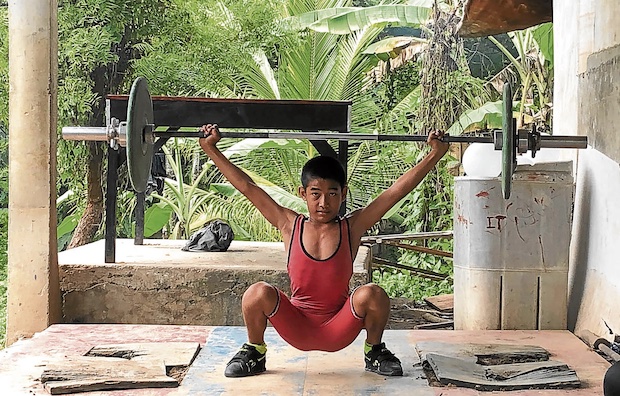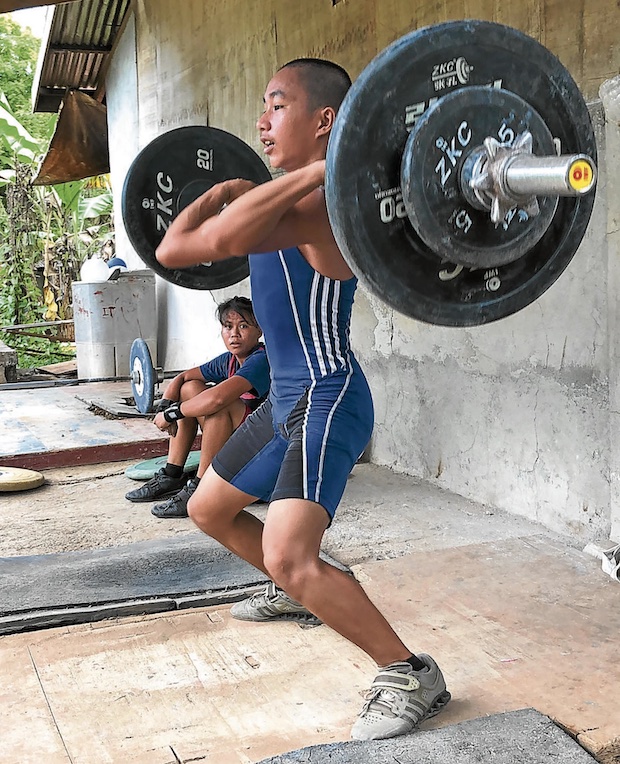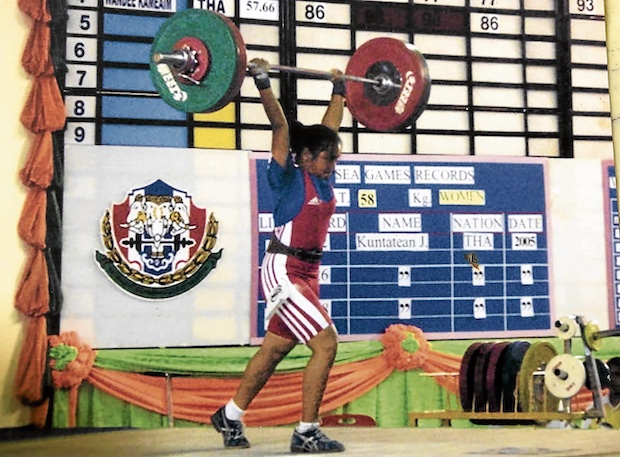
GETTING IN SHAPE: Aldrin Colonia, 13, is among the 15 young athletes that his uncle, former national athlete Gregorio Colonia, is training to become top-performing weightlifters despite limited resources and support from the government. (JULIE S. ALIPALA / Inquirer Mindanao)
ZAMBOANGA CITY, Zamboanga del Sur, Philippines — During the school break, Aldrin Colonia’s day starts by rushing toward the house of weightlifting coach Gregorio Colonia in Barangay Pasobolong here for a routine training and practice sessions at “the gym.”
There, 14 other young athletes are training according to designated schedules, taking turns in the two pullup bars, barbells, and in the use of a weightlifting singlet and shoes.
“We share suits, shoes and everything here,” the 14-year-old lifter told the Inquirer. “We cannot afford to have one of our own. Coach (Gregorio) said it’s very expensive,” he said, referring to the equipment and other needs that his uncle, Gregorio, made available for their use.
“What is important [is] we can practice every day,” said Annie Lacastesantos, another 14-year-old high school student, who contents herself in using shirts, tight shorts and old traditional weightlifting shoes with a hard heel. “[But] we have to follow schedules because the place is too small for two lifters,” she added.
Makeshift
The open structure where they practice was set up by Gregorio in 1995, out of his savings when he retired as a national athlete, to train his children and nephews in weightlifting. But since other children also got interested, he welcomed them to train for free.
Young athletes call the structure, about 800 meters from the main inner roads of Pasobolong, as “the Colonia Gym,” though it is strictly not a standard one. It is just a structure with a roof and two platforms on a broken floor. Underneath the platform, the soil is covered with thick rubber tire cutouts.
At least, young athletes who go there to train get their turn in lifting one of a dozen barbells and long bars.
“It serves as a daily exercise for the lifters,” said Gregorio, a professional weightlifter, and one of Olympian Hidilyn Diaz’s coaches during her 2002 Batang Pinoy games.
Gregorio’s makeshift facility is located less than a kilometer away from where he first trained Hidilyn under a tamarind tree, and some 18 kilometers from the city center.
“[To] jog or to walk [is] good for them but the gym can only accommodate two [athletes] per practice [session],” Gregorio said.

DETERMINATION: Mudsafar Sulaiman, 13, is determined to devote more time to his weightlifting training to follow in the footsteps of fellow Zamboangueño, Hidilyn Diaz, who made Philippine sports history by winning the country’s first gold medal in the Olympics. (JULIE ALIPALA / Inquirer Mindanao)
Growing interest
Following Hidilyn’s recent win at the Tokyo Olympics, young athletes like Lacastesantos, Aldrin and Mudsafar Sulaiman, a 13-year-old Tausug, are determined to follow in her footsteps.
“Every day, we get young children coming over, expressing interest in lifting. Unfortunately, we send home many because we cannot accommodate them all. We don’t want to train halfheartedly,” Gregorio said.
Lacastesantos, Aldrin and Sulaiman are among the 15 that Gregorio had chosen to transform, aided by this makeshift gym, into top-performing weightlifters. Their determination shows by investing their time in training, especially on weekends. During school days, they would train from 6 p.m. to 8 p.m.
Many times, Gregorio would shell out money for his wards’ food.
Although Aldrin can already lift 40-kilogram double weight and Lacastesantos is comfortable lifting 40 kg to 50 kg, both had no chance to show off their prowess because of the COVID-19 pandemic.
“What we do is practice,” Lacastesantos said. “Who knows, we can be part of Batang Pinoy or [the national] team?”
Where champs are made
So far, a number of those who began training at Gregorio’s makeshift gym have gone on to bring glory to the country in the international arena.
One is Gregorio’s nephew, Nestor, 29, who won gold in the 2015 Asian Championships and bronze for the clean and jerk event in the 2015 World and 2016 Asian Championships.
Another is Gregorio’s daughter Margaret, 22, an aircraft mechanic who was a silver medalist in the 59-kg class of the 2019 Southeast Asian (SEA) Games.
Long before Hidilyn, Margaret and Nestor, Gregorio notes that Zamboanga City has been a traditional source of weightlifters that carried the country’s banner in international competitions.
Most notable among them was the late Jaime Sebastian who dominated the super heavyweight division in the SEA Games from 1977 to 1989. Sebastian’s last appearance for the country was in the 1995 Chiang Mai Games when he brought home a bronze. He has since acted as coach of the national weightlifting team until his death in 2007.
Gregorio was among those who followed in the footsteps of Sebastian, competing in the flyweight division in the 1988 Seoul Olympics. He was in high school when he first competed in China in 1985, bagging a gold medal in the Asian Championships.
Two more Zamboangueños, Reinerio Hipolito (lightweight) and Levi Perez (bantamweight), represented the country in the Asian Championships.
The 58-year-old Gregorio waxed nostalgic when pondering how available training facilities for aspiring weightlifters in the city could be improved.
“There was no gym [during] our days. All we had was a space under the tamarind tree,” Gregorio recalled. He added that Hidilyn and her cousin Catalino Diaz, who also helped train her, also did their practice sessions this way.
Support needed
Although the makeshift gym is a bit of an improvement, Gregorio hopes the athletes can have more, asking the government to take a second look at how it can provide support.
“We have so many potentials in Zamboanga City. The sad part is our leaders and government officials will only notice them if someone brings home medals. But when it comes to sustainability in supporting our young lifters, none,” Gregorio lamented. “Congratulations are not enough, they have to support our athletes.”
He said the weightlifters have been struggling for support. “So when someone earns a medal, they really deserve it. Those were fruits of hard work,” Gregorio added.
According to Gregorio, the city has seven weightlifting clubs, but there are only three gyms with good amenities—one at the Universidad de Zamboanga with eight platforms; Hidilyn’s gym, with six; and a gym owned by Francisco “Kit” Mortera, with four.
The four others, including Gregorio’s own in Pasobolong, are all makeshift training centers, equipped with only two platforms.

INSPIRATION: Hidilyn Diaz, shown here as an 18-year old during a competition in Bohol province, has become an inspiration to young weightlifters in her hometown of Zamboanga City. (CONTRIBUTED)
Giving back
Hidilyn’s gym was built in Barangay Mampang, a little distance from her family home, out of the financial incentives she got from her silver medal finish in the 2016 Rio de Janiero Olympics.
According to Allen Diaz, the Olympian’s cousin who runs the gym, they don’t earn that much “because most of the young lifters are coming from poor families.” Currently, they rely on the sponsorship of 15 trainees by Alsons Power Group.
Gregorio said that even a little support from the government could go a long way.
“If they can build waiting sheds and open courts, why can’t they construct a gym in the barangay for future weightlifters?” he asked.
“We are not asking for the impossible from our local government officials in Zamboanga City,” added Gregorio’s daughter Margaret. “All we ask is a small area, which we can convert into a training ground. Or, perhaps, just a bag of cement, training equipment for squatting, a small barbell for our starters; maybe, even a bottle of vitamins.”
Gregorio also called on those who made money on the back of successful athletes to pitch in.
“Other coaches who were not actually professional coaches enriched themselves by earning from the incentives of their athletes. I don’t want to name names but I am hoping that they can extend some help, even just a sack of rice for the children,” said Gregorio, a weightlifting coach of the Philippine Sports Commission.
When asked about the city government’s support for the athletes, Mayor Maria Isabelle Climaco Salazar, however, said there was no budget for the purpose.
“The city sports division would be tasked to do the necessary recommendations and we cannot allocate funds for the purpose,” she said. “It is a fact that young people will set their eyes on weightlifting because of Hidilyn’s recent Olympic win,” Salazar said in an online press conference on July 30.
Gregorio thanked Diaz for “giving back” through her fully furnished gym, “providing what was deprived of her as a young and aspiring athlete.”
Hidilyn’s victory, according to Gregorio, not only brought pride and honor for all the Filipinos but was also “an eye-opener for our leaders who may have overlooked the needs of our lifters in the communities.”
Get the hottest sports news straight into your inbox
Read Next
Subscribe to INQUIRER PLUS to get access to The Philippine Daily Inquirer & other 70+ titles, share up to 5 gadgets, listen to the news, download as early as 4am & share articles on social media. Call 896 6000.















































